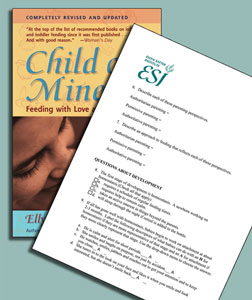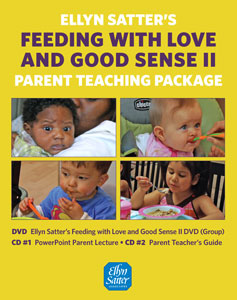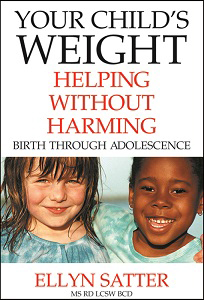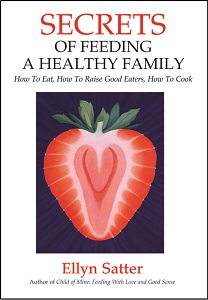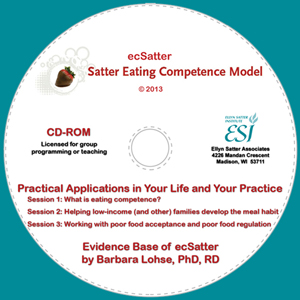
Learn more about the Satter trust models
The Satter Feeding Dynamics and Satter Eating Competence modelsOpen your life to new relationships
With food, with other eaters, with other feeders
Practicing with the Satter Feeding Dynamics model (fdSatter) and Satter Eating Competence model (ecSatter) will amaze you and give you joy! You don’t have to advocate avoidance and restriction and tell others what to eat, how much to eat, and what to weigh. Instead, you can trust others to act on their own behalf and join with them in finding ways to eat and feed wisely and well.
Workshops and webinars
- Watch the ESI website and ESI emails for training opportunities.
- Consider our in-depth, extraordinarily grounding three-day VISION workshops: Feeding with Love and Good Sense and Treating the Dieting Casualty.
- Interest your agency in sponsoring a workshop on one of these topics.
Self-study guides
- Satter Eating Competence Model (ecSatter) Self-Study Guide
- Satter Feeding Dynamics Model (fdSatter) Self-Study Guide
- Child weight issues
- Feeding therapy
CEU examinations
Available from the ESI store
- Child of Mine CEU Examination. Fun, entertaining, educational, and challenging.
- Your Child’s Weight CEU Examination.
Facebook community
Both groups support mutual help with others who are also bringing themselves along with understanding and practicing eating and feeding according to ecSatter and fdSatter. If you find yourself stumbling on research, issues and questions, raise them on Facebook.
Mentoring programs
Consultation on your project
- Consult the Evaluation Rubric from the Perspective of ecSatter and fdSatter
- Get consultation with an ESI faculty member
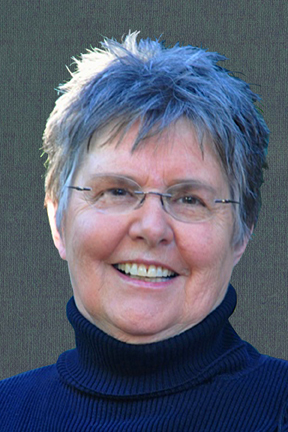
A message from Ellyn Satter . . .
I am so pleased about your interest in the feeding dynamics and eating competence models and welcome you as a fellow traveler! I hope you find, as have many others before you, that the trust models make all the difference in your relationship with food and with other eaters and feeders. For some, it is like being reborn to be relieved of conflict, guilt, and negativity about eating and feeding. For others, it is just a relief! You don’t have to scold, lecture, or motivate yourself or others. Instead, you get to understand, trust, join with others right where they are, and have fun sharing adventures with eating and feeding. Yours in joyful eating and feeding,
Get on the ESI mailing list to hear about what’s important, what’s new
- Read the monthly ESI blog
- Read the featured Family Meals Focus articles
- Watch for new publications, webinars, training
Contact us with your questions about feeding and eating
Satter Feeding Dynamics Model (fdSatter) self-study guide
Below is a listing of reading and work you can do on your own or in a study group with colleagues. With all activities, do you your best to understand, but if you get stuck, ask on Facebook for professionals.
CEU credits for RDs
Since we can’t test your understanding, we can’t support you in getting credits for Sponsored Independent Learning. You can, however, use this self-study activity as Professional Reading, or join with at least two other people to have a Study Group or Journal Club.
Self-study
- Read the following lists of materials in Resources and links for professionals.
- Division of responsibility in feeding and activity
-
Feeding dynamics definition and evidence
-
Handouts and educational resources
- Professional articles: Read the first five, four of which are letters to the editor
- To understand the theory and practice of feeding dynamics and the developmental aspects of feeding, read and study Child of Mine: Feeding with Love and Good Sense. Be sure to read the appendixes. As you read, check your understanding with this handout: Developmental guidelines for feeding infants and young children.
- To test your understanding of the theory and practice of feeding dynamics and developmental aspects of feeding, take the Child of Mine CEU Examination. This exam is fun, entertaining, educational, and challenging.
- To understand how the theory and practice of feeding dynamics and developmental aspects of feeding applied to the prevention and treatment of child overweight and obesity, read Your Child’s Weight: Helping Without Harming. Again, be sure to read the appendixes.
- To test your understanding of applying fdSatter and ecSatter to understanding and intervening with childhood weight issues, take the Your Child’s Weight CEU Examination.
- Work your way through the videos and lesson plans in Ellyn Satter’s Feeding with Love and Good Sense II: Parent Teaching Package. The videos demonstrate what you learned from your reading. Viewing them sharpens your observational skills and reinforces your understanding of fdSatter.
- Review and understand the practice guidelines relative to pediatric feeding disorders and child obesity. Take particular care to understand the difference between the feeding dynamics model and conventional approaches.
- Review the ESI position statements on child overweight, child diabetes, and cystic fibrosis.
- Participate in ESI webinars.
Satter Eating Competence Model (ecSatter) self-study guide
Below is a listing of reading and work you can do on your own or in a study group with colleagues. With all activities, do you your best to understand, but if you get stuck, ask on Facebook for professionals.
CEU credits for RDs
Since we can’t test your understanding, we can’t support you in getting credits for Sponsored Independent Learning. You can, however, use this self-study activity as Professional Reading, or join with at least two other people to have a Study Group or Journal Club.
Self-study
- Under Eating Competence, Read the following lists of materials in Resources and links for professionals.
- Definition and evidence
- Handouts and educational resources
- Professional articles: Read the first six.
- View Barbara Lohse’s webinar, The evidence base for the Satter Eating Competence Model. Note correlation between ecSI, increased activity, better sleep, better parenting, and more.
- Read and study Secrets of Feeding a Healthy Family.
- For an understand of eating competence, pay particular attention to Part 1, “How to Eat.”
- To understand ecSatter’s permission-giving and sensible approach to food selection, pay particular attention to Chapter 13, “Choosing food.”
- ecSatter does not impose limits on fat and salt and extol weight loss. Instead, ecSatter relies on biospychosocial processes to produce moderation, balance, and weight-neutral wellness. To understand the research that supports this less-regimented approach to food and weight management, read these Secrets of Feeding a Healthy Family appendixes:
- What surveys say about our eating
- BMI, mortality, morbidity and health
- Diet and degenerative disease
- A primer on dietary fat
- Sodium in your diet
- Study the Satter Eating Competence Model Webcast Series on CD. This explains eating competence in practical, accessible terms. It also gives live demonstrations of applying ecSatter principles to typical adult eating issues: lack of interest in nutritional guidelines, picky eating, weight problems. Find out what Ellyn Satter means by nutritional judo.
- To keep up with the ecSatter evidence as it emerges, see the Barbara Lohse’s Rochester Institute of Technology NEEDS website: Evidence-base of Satter Eating Competence Model. Note correlations with increased activity and with improved cardiovascular biomarkers. And more.

